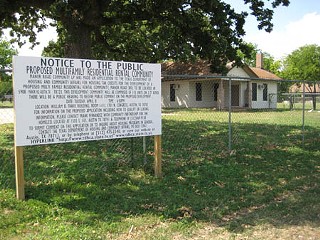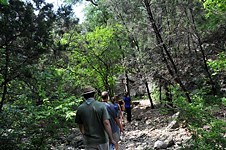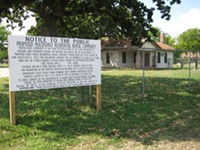Manor Road Housing Project Looking for a Home
Neighborhoods balk at a proposed homeless and low-income housing development on Manor Road
By Lydia Crafts, Fri., June 20, 2008

Although the Planning Commission voted last week in favor of rezoning 5908 Manor Rd. to enable an affordable housing development, odds are the project will not survive an upcoming City Council meeting.
Community Partnership for the Homeless, an affordable housing developer, has requested rezoning the private park on Manor Road, on the border of the Windsor Park and Pecan Springs neighborhoods, from higher-density single-family homes to mixed use (with conditional overlays regulating the height and setbacks). The developer hopes to build a 110-efficiency-unit facility, with two-thirds of the space designated for people earning less than $25,000 per year and the remaining one-third for the formerly homeless who have proved their stability in transitional housing or treatment programs.
Despite the surrounding neighborhoods' opposition to the development, the Planning Commission voted 6-3 in favor of the rezoning because of Austin's growing demand for affordable living options. However, the surrounding Windsor Park, University Hills, and Pecan Springs neighborhoods have a powerful tool at their disposal: a valid petition with the signatures of more than 70% of the household owners living within 200 feet of the area, meaning City Council would have to pass the rezoning with a supermajority vote of 6-1. (Originally scheduled to go to council in June, the proposal will now be considered at the July 24 meeting.)
The neighborhoods have some persuasive arguments, making it unlikely Community Partnership will be able to sway six City Council members to endorse the rezoning. One of the sticking points with the neighborhood is the density of the project. While the frontage of the park – which faces Manor Road and is flanked by a Dairy Queen – appears suitable for apartments, it could be considered out of character with the single-family homes and duplexes abutting the rear of the property.
Opposition to the project has also been fueled by the fact that the Windsor Park and University Hills communities just completed their neighborhood plan last August. Working with city staff, residents prioritized attracting more businesses and single-family home developers with the hope of revitalizing the area. Although affordable housing is part of the neighborhood plan, the communities argue that the area is already overrun with these types of developments, in contrast to the wealthier west side.
"That's the whole point of contention," said Paul Saldaña, a spokesperson for the Northeast Austin Business and Community Alliance, which formed earlier this year in response to the CPH proposal. "Throughout the two-year investment on the part of the neighborhood [in the neighborhood plan], there was no mention of a homeless facility."
Along with frustration over the neighborhood plan, the community fears that crime in the area will place the vulnerable population served by the development at risk. The Austin Police Department provided the community with crime statistics showing 682 incidents within 1,000 feet of the park in the past two years.
But the crime argument has been discredited by many studies arguing that well-managed supportive housing developments can actually improve neighborhood safety – and Frank Fernandez, executive director of Community Partnership, seems determined to ensure that this facility will be well-managed. Describing other supportive housing projects in the area as "unfit for human habitation," he has promised to install cameras throughout the building and demonstrate "zero tolerance" for criminal activity. Community Partnership would conduct criminal background checks on its tenants and would staff the facility 24 hours a day with supportive services. Although CPH has never managed a property of this size, it has employed Foundation Communities, an affordable housing developer of large multifamily complexes, as a consultant on the project. Fernandez is passionate about providing safe, affordable housing to low-income and formerly homeless populations. "There is a savagely acute need for this type of housing in our community," he said.
Although some residents might deny it, a widespread fear of the homeless seems to weigh heavily in the opposition to the development. Neighbors have derided the project inaccurately as a "homeless hotel," and Saldaña admitted the word "homeless" raises a red flag for many residents.
At the June 10 Planning Commission meeting, formerly homeless clients of CPH, including a veteran and a woman who worked 25 years as an occupational therapist, gave emotional addresses in support of the development. They demonstrated that the homeless population CPH serves is far more diverse than might be generally assumed.
While Austin is woefully short on affordable living options, Margaret Shaw, director of the city's Neighborhood Housing and Community Development, said permanent housing with supportive services is even more rare. When a homeless person moves out of transitional housing (long-term temporary housing with a three-to-24-month occupancy limit), he or she often has nowhere to go but the street. Moreover, the city has no other similar projects proposed right now – and they don't come along often.
"People of low income have a right to a high quality of life," said Arthur Sampson, a veteran who lives 600 feet from the park and supports the project.
Editor's note: The above story inadvertently omitted reference to Arthur Sampson's ownership of the land at issue, because we were not aware of it. CPH has since confirmed that Sampson indeed owns the tract.
Got something to say on the subject? Send a letter to the editor.










